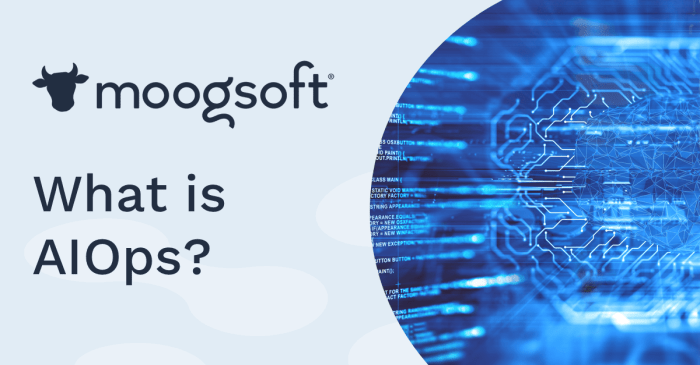What You Need to Know About AIOps: In the ever-evolving landscape of IT, where complexity and data volume are constantly increasing, the need for intelligent solutions has become paramount. Enter AIOps, a revolutionary approach that leverages the power of artificial intelligence (AI) and machine learning (ML) to transform the way we manage and optimize our IT operations.
AIOps is not just a buzzword; it’s a paradigm shift that promises to streamline processes, enhance efficiency, and ultimately empower organizations to achieve their digital transformation goals. This guide will delve into the core concepts of AIOps, exploring its key technologies, use cases, implementation strategies, and the exciting future that lies ahead.
What is AIOps?
AIOps, short for Artificial Intelligence for IT Operations, is a relatively new approach to managing IT infrastructure and applications. It leverages machine learning, big data analytics, and automation to automate and improve IT operations processes. AIOps is designed to help organizations proactively identify and resolve IT issues before they impact users, thereby improving the overall IT service experience.
AIOps Key Components
AIOps involves several key components working together to achieve its objectives:
- Data Collection and Ingestion:AIOps platforms gather data from various sources, including logs, metrics, events, and traces. This data provides a comprehensive view of the IT environment.
- Data Analysis and Correlation:Advanced analytics techniques are used to analyze the collected data, identify patterns, and correlate events to pinpoint root causes of problems.
- Automation and Orchestration:Automation tools are used to execute predefined actions based on insights derived from data analysis. This includes tasks like automatically resolving issues, scaling resources, and deploying updates.
- Machine Learning and AI:Machine learning algorithms are used to predict potential issues, detect anomalies, and optimize resource allocation. AI-powered chatbots can provide real-time assistance to IT personnel and users.
Evolution of AIOps, What you need to know about aiops
AIOps represents an evolution from traditional IT operations management (ITOM) practices. While traditional ITOM relied heavily on manual processes, reactive troubleshooting, and limited data analysis, AIOps brings a more proactive, data-driven approach.
- Shift from Reactive to Proactive:AIOps empowers organizations to move away from reactive troubleshooting, where issues are addressed after they occur, to a proactive approach where potential problems are identified and mitigated before they impact users.
- Increased Automation:AIOps leverages automation to reduce manual tasks, freeing up IT personnel to focus on higher-value activities. This leads to increased efficiency and reduced operational costs.
- Data-Driven Insights:AIOps platforms analyze vast amounts of data to uncover hidden patterns and insights that would be difficult to detect manually. This enables organizations to make more informed decisions about their IT infrastructure and operations.
Benefits of AIOps
Implementing AIOps in modern IT environments offers several benefits:
- Improved Service Availability and Reliability:AIOps helps organizations proactively identify and resolve issues, leading to improved service availability and reduced downtime.
- Faster Incident Resolution:By automating incident detection and resolution, AIOps significantly reduces the time it takes to address IT problems. This leads to faster recovery times and improved user satisfaction.
- Reduced Operational Costs:AIOps helps organizations optimize resource utilization, reduce manual tasks, and streamline operations, resulting in lower operational costs.
- Enhanced IT Efficiency:AIOps frees up IT personnel from repetitive tasks, allowing them to focus on strategic initiatives and innovation. This leads to a more efficient and productive IT team.
- Improved Security Posture:AIOps can help identify security threats and vulnerabilities by analyzing data patterns and correlating events. This enables organizations to respond to threats more quickly and effectively.
Key Technologies in AIOps
AIOps is not just a buzzword; it’s a practical approach to IT operations that relies on a powerful combination of technologies. The core technologies that drive AIOps are artificial intelligence (AI), machine learning (ML), data analytics, visualization, and automation. These technologies work together to provide a holistic solution for managing complex IT environments.
Role of AI and ML in AIOps
AI and ML are the driving forces behind AIOps. They empower systems to learn from historical data and identify patterns, anomalies, and potential problems. This allows for proactive monitoring and incident resolution.
- Anomaly Detection:AI algorithms can analyze vast amounts of data to identify unusual patterns that might indicate a problem. For example, a sudden spike in CPU utilization or an increase in error logs can be detected and flagged as potential issues.
- Predictive Maintenance:ML models can predict when a component might fail based on historical data. This allows IT teams to proactively address potential issues before they impact service availability. For instance, an ML model can predict the failure of a hard drive based on its temperature, vibration, and other performance metrics.
- Root Cause Analysis:AI and ML can help pinpoint the root cause of incidents by analyzing logs, metrics, and other data sources. This speeds up the troubleshooting process and helps prevent similar issues from recurring. For example, an AI-powered tool can analyze logs from multiple systems to identify a specific configuration change that caused a service outage.
Data Analytics and Visualization Tools in AIOps
AIOps relies heavily on data analytics to extract meaningful insights from vast amounts of data generated by IT systems. Visualization tools help present this data in an easily understandable format.
- Data Collection and Aggregation:AIOps platforms collect data from various sources, including monitoring tools, logs, metrics, and user feedback. This data is then aggregated and normalized to provide a unified view of the IT environment.
- Data Analysis and Correlation:AI and ML algorithms analyze the aggregated data to identify patterns, trends, and anomalies. These insights can be used to proactively identify potential problems and optimize IT operations.
- Data Visualization:Visualization tools present the analyzed data in a clear and concise manner, enabling IT teams to quickly understand the health and performance of their systems. Dashboards and visualizations can show real-time performance metrics, incident trends, and root cause analysis results.
Automation and Orchestration in AIOps
Automation and orchestration are essential for scaling AIOps solutions and maximizing efficiency. They enable the automation of repetitive tasks and the coordination of complex workflows.
- Automated Incident Response:AIOps platforms can automatically trigger remediation actions based on predefined rules and policies. For example, if a system experiences high CPU utilization, the platform can automatically scale up resources or restart the service.
- Workflow Automation:AIOps tools can automate complex workflows, such as incident management, change management, and service provisioning. This reduces manual effort and improves the efficiency of IT operations.
- Self-Healing Systems:With automation, AIOps can enable self-healing systems that can automatically identify and resolve issues without human intervention. This reduces the impact of incidents and improves service availability.
AIOps Use Cases

AIOps offers a wide range of practical applications across various IT operations domains, enabling organizations to improve efficiency, enhance performance, and optimize resource utilization. Here are some prominent use cases that demonstrate the transformative potential of AIOps:
Incident Management
AIOps significantly enhances incident management by automating the process of identifying, prioritizing, and resolving incidents. By analyzing vast amounts of data from diverse sources, AIOps tools can quickly pinpoint the root cause of issues, even those that are complex and multifaceted.
This enables faster resolution times and reduces the impact of outages on business operations.
- Automated Incident Detection:AIOps systems can monitor logs, metrics, and other data sources in real-time to detect anomalies and potential incidents before they escalate into major problems. Machine learning algorithms can identify patterns and deviations from normal behavior, triggering alerts and initiating automated remediation actions.
- Root Cause Analysis:AIOps tools leverage advanced analytics and correlation techniques to identify the root cause of incidents, even in complex environments with interconnected systems. By analyzing historical data and identifying patterns, AIOps can pinpoint the exact source of the issue, eliminating guesswork and enabling faster resolution.
- Incident Prioritization:AIOps platforms can prioritize incidents based on their severity and potential impact on business operations. This allows IT teams to focus on the most critical issues first, ensuring that the most important services are restored quickly and efficiently.
Proactive Monitoring and Capacity Planning
AIOps plays a crucial role in proactive monitoring and capacity planning by providing insights into system performance and resource utilization trends. This enables organizations to anticipate potential bottlenecks and proactively adjust capacity to meet growing demands.
- Predictive Analytics:AIOps tools can analyze historical data and current trends to predict future system performance and resource utilization. This enables organizations to proactively scale infrastructure and allocate resources to meet anticipated demands, avoiding performance degradation and ensuring service availability.
- Capacity Optimization:By analyzing resource utilization patterns, AIOps systems can identify opportunities for optimization and cost reduction. For example, they can recommend adjustments to infrastructure configurations or identify underutilized resources that can be reallocated to improve efficiency.
- Performance Tuning:AIOps tools can identify performance bottlenecks and recommend adjustments to system configurations to optimize performance and reduce latency. By analyzing performance metrics and identifying areas for improvement, AIOps can help organizations achieve optimal system performance.
Security Threat Detection and Response
AIOps is increasingly used for security threat detection and response, leveraging its capabilities to analyze vast amounts of security data and identify suspicious patterns that may indicate malicious activity.
Browse the multiple elements of esa stilfold plan bring industrial origami to outer space to gain a more broad understanding.
- Anomaly Detection:AIOps systems can monitor network traffic, user behavior, and other security-related data to detect anomalies that may indicate a security breach. Machine learning algorithms can identify deviations from normal patterns, triggering alerts and initiating security investigations.
- Threat Intelligence Integration:AIOps platforms can integrate with threat intelligence feeds to enrich their analysis and provide context for detected anomalies. This allows them to identify known threats and prioritize investigations based on their potential impact.
- Automated Response:In some cases, AIOps systems can be configured to automatically respond to security threats. For example, they can isolate infected systems, block malicious traffic, or initiate other security protocols to mitigate the impact of attacks.
Implementing AIOps

Implementing AIOps can be a complex and challenging process, requiring careful planning and execution. It involves integrating various technologies and processes to achieve the desired outcomes. This section will delve into the key challenges and considerations involved in implementing AIOps, including selecting and deploying AIOps tools, and integrating them with existing IT infrastructure and processes.
Challenges and Considerations
Implementing AIOps presents several challenges and considerations that need to be addressed for successful adoption. These challenges are often interconnected and require a holistic approach for effective resolution.
- Data Integration and Management:AIOps relies on collecting and analyzing data from various sources, including logs, metrics, events, and traces. Integrating data from different systems and formats can be challenging, requiring careful data cleansing, transformation, and normalization. Additionally, managing the volume and velocity of data can be a significant hurdle, necessitating efficient storage and processing capabilities.
- Tool Selection and Deployment:Selecting the right AIOps tools is crucial for achieving the desired outcomes. This involves considering factors such as the specific use cases, the existing IT infrastructure, and the budget. Deployment of AIOps tools can also be complex, requiring careful planning and coordination with existing systems and processes.
- Skill Gap and Training:Implementing AIOps requires specialized skills in areas such as data science, machine learning, and IT operations. Bridging the skill gap and training existing IT staff can be a significant challenge.
- Organizational Change Management:Implementing AIOps requires a change in the way IT operations are conducted, leading to potential resistance from staff who may be accustomed to traditional methods. Implementing a robust change management program is crucial to ensure smooth adoption and minimize disruption.
- Security and Privacy:AIOps involves processing sensitive data, making security and privacy a critical consideration. Ensuring data security and compliance with relevant regulations is essential to prevent unauthorized access and data breaches.
Selecting and Deploying AIOps Tools
Selecting and deploying AIOps tools requires a structured approach to ensure a successful implementation. The following steps can guide the process:
- Define Use Cases:Clearly define the specific use cases for AIOps, such as incident detection, root cause analysis, or performance optimization. This will help narrow down the tool selection process and focus on tools that best address the defined needs.
- Evaluate Tools:Evaluate different AIOps tools based on their capabilities, features, and compatibility with existing IT infrastructure. Consider factors such as data integration, analysis capabilities, reporting features, and user interface.
- Pilot Deployment:Implement a pilot deployment of the selected AIOps tools in a controlled environment to assess their performance and effectiveness. This will help identify any potential issues and fine-tune the configuration before full-scale deployment.
- Phased Rollout:Roll out the AIOps tools in phases, starting with a small subset of systems and gradually expanding the scope. This allows for continuous monitoring and adjustments to ensure a smooth transition.
- Continuous Monitoring and Optimization:Monitor the performance of the AIOps tools after deployment and make necessary adjustments to optimize their effectiveness. This includes regular reviews of the tools’ configuration, data integration, and reporting capabilities.
Integrating AIOps with Existing IT Infrastructure and Processes
Integrating AIOps with existing IT infrastructure and processes is essential for seamless operation and to avoid disrupting existing workflows.
- Data Integration:Establish data integration mechanisms between AIOps tools and existing IT systems to ensure a consistent flow of data. This may involve using APIs, data connectors, or custom scripts.
- Process Automation:Automate repetitive tasks and workflows using AIOps tools to improve efficiency and reduce manual intervention. This can include tasks such as incident response, remediation, or system configuration.
- Collaboration and Communication:Integrate AIOps tools with existing collaboration and communication platforms to ensure seamless communication between IT teams and stakeholders. This can include tools such as ticketing systems, chat platforms, or notification systems.
- Training and Support:Provide training and support to IT staff on using AIOps tools and integrating them into existing workflows. This will help ensure smooth adoption and minimize disruptions.
The Future of AIOps: What You Need To Know About Aiops
AIOps is rapidly evolving, driven by advancements in artificial intelligence (AI), cloud computing, and the increasing complexity of IT environments. The future of AIOps holds exciting possibilities for transforming IT operations and enabling organizations to achieve their digital transformation goals.
Emerging Trends in AIOps
The rapid evolution of AIOps is driven by several emerging trends that are shaping the future of IT operations. These trends are creating new opportunities for organizations to leverage AIOps for greater efficiency, agility, and resilience.
- Cloud-Native Technologies:The adoption of cloud-native technologies, such as containers and serverless computing, is driving the need for AIOps solutions that can effectively manage these dynamic environments. AIOps platforms are increasingly being designed to integrate with cloud-native tools and services, providing real-time insights and automation capabilities for cloud-based applications.
- Edge Computing:The rise of edge computing is creating new challenges for IT operations, as data is generated and processed closer to the source. AIOps solutions are being extended to the edge to provide real-time monitoring, analysis, and remediation capabilities for edge devices and applications.
- AI-Driven Automation:AIOps is increasingly leveraging advanced AI techniques, such as machine learning and deep learning, to automate IT operations tasks. This includes tasks like incident detection, root cause analysis, and automated remediation, freeing up IT teams to focus on more strategic initiatives.
- Data-Driven Decision Making:AIOps platforms are becoming more sophisticated in their ability to collect, analyze, and visualize data from various sources. This data-driven approach empowers IT teams to make informed decisions based on real-time insights and historical trends.


